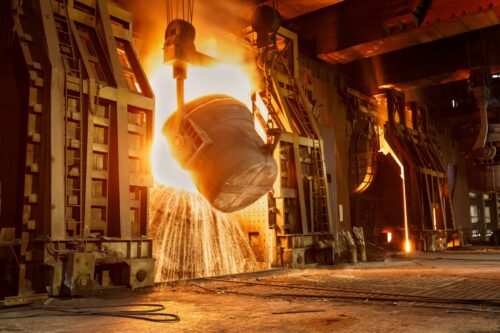
The Sustainable STEEL Principles: Forging a New Paradigm
The world’s biggest financial institutions have embraced the goal of limiting warming to 1.5°C (2.7°F) to avoid the worst consequences of climate change. The Glasgow Financial Alliance for Net Zero, launched at the COP26 climate conference in 2021, brings together over 500 firms in the financial sector to accelerate the transition to net-zero emissions by 2050 at the latest. Many of these firms are now working to chart the path to achieving these goals in partnership with the companies and industries they finance.
On September 23, at Climate Week NYC, six signatory banks — Citi, Crédit Agricole CIB, ING, Société Générale, Standard Chartered, and UniCredit — launched a climate-aligned finance agreement for the steel sector: the Sustainable STEEL Principles. Together these banks represent $23 billion in lending commitments to the steel sector.
The Sustainable STEEL Principles
The Sustainable STEEL Principles (SSP) are the turnkey solution for measuring and disclosing the alignment of steel lending portfolios with 1.5°C climate targets. Climate-aligned finance agreements such as the SSP can help banks set impactful targets, support the practical achievement of net-zero emissions in carbon-intensive industries, and provide financial institutions with the tools for effective client engagement and advocacy. (STEEL stands for the five principles of the agreement: standardized assessment, transparent reporting, enactment, engagement, and leadership.)
The Sustainable STEEL Principles were inspired by the Poseidon Principles, a similar framework that was launched in 2019 by financial institutions as a commitment to implementing climate-related principles in the shipping sector. Since their launch, the Poseidon Principles have grown to become a global climate standard, with signatory banks now representing an estimated 50 percent of the global ship finance portfolio, billions in emissions-linked debt having been issued, and the emergence of a network of initiatives leveraging the methodology behind the Principles.
With the launch of the SSP, the paradigm has been forged: a sector-specific methodology, access to robust data, and a common measurement and disclosure platform that is essential to impactful client engagement and action in the real economy.
Navigating a Massive Transformation
The significance of the Sustainable STEEL Principles is in how they navigate the net-zero steel finance paradox.
If the iron and steel sector were a country, its annual greenhouse gas emissions would rank third in the world, behind only China and the United States. And the industry is only expected to grow, with demand for steel projected to increase 30 percent by 2050.
While zero-carbon steel is technologically possible, it is relatively expensive today, and deployment will require commercial-scale development and coordination across the entire value chain. According to an analysis by the Mission Possible Partnership, transitioning the global steel asset base to net-zero-compliant technologies will require an additional $8 billion to $11 billion in investment annually — equal to $235 billion to $335 billion of additional total investment by 2050.
Somewhat paradoxically, it is therefore imperative that lenders — as the largest source of capital for the sector — increase the flow of funds to the high-emitting steel sector to support its transition while simultaneously pursuing their individual net-zero goals.
The Sustainable STEEL Principles navigate this challenge adeptly. The Principles are a voluntary framework, providing banks and their clients with actionable, near-term pathways to net zero and a methodology for measuring progress along those pathways.
Banks can use the Principles to chart out the low-carbon transition for each client against a company-specific emissions reduction pathway. The Principles can also help banks and their clients discuss opportunities for transitional switches, including the financing tools for those switches. Critically, lenders that adopt the Principles make annual disclosures on their progress toward net zero, in line with the guidelines of the U.N.-convened Net-Zero Banking Alliance, and can optionally report on the percentage of their portfolio with net-zero targets. By improving the transparency and reporting standards of steel sector banking, the SSP can drive accountability and accelerate the flow of funds to responsible, near-zero-CO2 steel production techniques worldwide.
A Shared Vision from Diverse Viewpoints
This climate standard was developed by an otherwise unlikely group of metals and mining bankers and climate specialists from all over the world, with technical guidance provided by RMI. The working group was led by ING, co-led by Société Générale, and included Citi, Standard Chartered, and UniCredit. During the 15 months of development, more than 80 additional institutions across finance, industry, and civil society were consulted. While the decision-making was left up to the five lenders leading the working group, the aim was to build consensus among financial institutions, steel producers, and technical experts. The diverse viewpoints and sometimes competing agendas of these stakeholders led to a complex consultation process. Ultimately, however, a shared vision for action was molded in the fire of those debates.
Banks that join the SSP send a clear message: ambition must be backed by decisive action. With the launch of the Principles, financial institutions finally have the tools to put the pedal to the metal in advancing a net-zero steel sector. We invite all interested financial institutions to join their peers in adopting this groundbreaking, ready-to-implement sustainable finance framework. This is an opportunity for the financial sector, in advance of COP27, to demonstrate to the world that it is up to the task of the transition, ready to back up climate promises with climate actions.